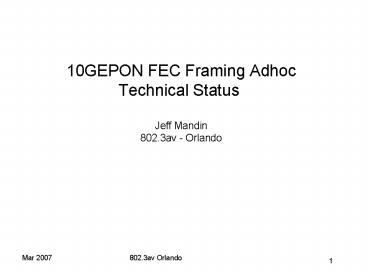10GEPON FEC Framing Adhoc Technical Status Jeff Mandin 802.3av - Orlando - PowerPoint PPT Presentation
Title:
10GEPON FEC Framing Adhoc Technical Status Jeff Mandin 802.3av - Orlando
Description:
Data 0 (Scrambled) FEC codeword. data size. FEC codeword ... Streaming FEC is applied at the lowest layer (ie. scrambled 66b blocks are input to FEC encoder) ... – PowerPoint PPT presentation
Number of Views:54
Avg rating:3.0/5.0
Title: 10GEPON FEC Framing Adhoc Technical Status Jeff Mandin 802.3av - Orlando
1
10GEPON FEC Framing AdhocTechnical Status Jeff
Mandin802.3av - Orlando
2
Agenda
- Summary of adhoc discussions on upstream framing
and lock - behaviour of OLT and ONU
- ONU PCS behaviour
- Open Issues on Upstream
- Downstream
- Motion
3
Burst mode behaviour OLT and ONU
- At the start of the burst the ONU transmits a
binary 101010 pattern (sync pattern) to
facilitate clock recovery and gain control at OLT
receiver. - To establish byte-level and FEC-codeword-level
synchronization, the ONU transmits a 66bit
Barker-like sequence (which must have high
Hamming distance from all shifts of itself
concatenated with the sync pattern). The
specific bit sequence is TBD. We call this
sequence the delimiter. - The OLT receiver searches for the delimiter in
the received datastream with a certain tolerated
number of bit errors. Upon detecting the
delimiter, the OLT knows the byte and codeword
alignment of the incoming datastream. - The datastream of FEC codewords (consisting of a
series of scrambled 66b blocks containing user
data followed by FEC parity also contained in 66b
blocks) begins immediately following the
delimiter. - The FEC-encoded datastream begins with a
sufficient number of leading IDLEs so as to
initialize the OLT receivers self-synchronous
scrambler.
4
Burst phases
- There are six phases in the burst lifetime
- Between bursts
- Turning the transmitting laser on
- Transmitting the sync pattern
- Transmitting the delimiter
- Transmitting data (with FEC parity)
- Turning the transmitting laser off
- These phases are cyclical.
5
Burst Phases (2)
6
Details of Burst Elements
Burst Delimiter
Data (ie. series of FEC codewords)
Sync pattern (0101010)
Sync pattern (0101010)
CW 0
Integer of 66b blocks
66 bits
Integer of 66b blocks
Data 0 (Scrambled)
Parity 0
66b block 0
FEC codeword data size
FEC codeword parity size
7
ONU PCS behaviour
- Streaming FEC is applied at the lowest layer (ie.
scrambled 66b blocks are input to FEC encoder) - The ONU PCS continues to transmit to the PMA
between bursts - The ONU PCS initiates the burst initialization
and transmission cycle when it determines that
burst data is arriving from the MAC layer. - Since lead time is necessary for laser
stabilization, the PCS layer delays all the data
that it receives from the MAC (cf. data
detector in 802.3ah) - ONU PCS maintains awareness of the amount of time
needed for - Laser on stabilization
- Worst-case OLT receiver calibration (ie. how long
to transmit the sync pattern after laser
stabilization) - ONU PCS completes the burst cycle (by turning
laser off) following transmission of a complete
FEC block to the PMA when no more burst data is
pending.
8
FEC location in PCS
Note Data detector placement is an open issue
and so the data detector (which activates laser
on/off) is not shown. Additional functional
blocks may be added as state machines are refined.
9
Open Issues
- System Issues
- What are the events that trigger the ONU PCS to
invoke laser on/laser off (and by implication the
start and end of burst)? - Arrival of an XGMII code containing a non-IDLE
code to the top of the PCS (laser on) and all
IDLEs (laser off) - or
- Arrival (to the bottom of the PCS) of a series of
66b blocks with 2bit sync headers which imply the
presence of user frame data (laser on) and
absence of frame data (laser off) - What alignment should the PCS perform during
burst initialization? - Only align the FEC codeword stream to the start
of the data burst (ie. the leading IDLEs will
occur in the first 66b block of the first FEC
codeword) - or
- b) In addition to aligning the FEC codeword
stream to the start of the burst, align the 66b
block stream also (so that the FEC codeword will
include precisely the requisite number of leading
IDLEs)
10
Open Issues(2)
- PCS Design/Specification Issues
- Placement of Data Detector
- Depends on decision regarding trigger event
- Assignment of functionality to blocks within the
PCS - Our new functionality in a single functional
block? or more than one? - State diagrams
- Unified state diagram for burst control? or is
there more than one process?
11
Motion
- To accept the scheme outlined in slides 3-8 of
this presentation as the baseline scheme for
upstream FEC framing and synchronization
12
Motion
- To accept the FEC codeword structure depicted in
the illustration on slide 6 for the downstream
(so that the FEC codeword structure on the
upstream and downstream is identical).

